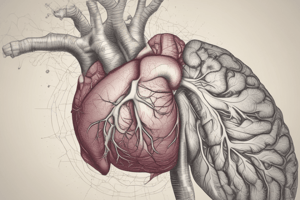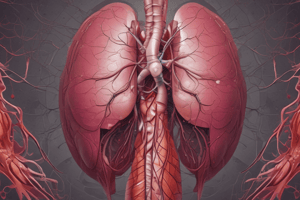Podcast
Questions and Answers
What is the main reason why the right lobe of the liver is susceptible to damage?
What is the main reason why the right lobe of the liver is susceptible to damage?
- Due to its proximity to the lungs. (correct)
- Due to its proximity to the spleen.
- Due to its proximity to the diaphragm.
- Due to its proximity to the stomach.
What percentage of patients with amebic abscess are jaundiced?
What percentage of patients with amebic abscess are jaundiced?
- 75%
- 90%
- 22% (correct)
- 50%
What is the main function of the liver that is being referred to when discussing albumin?
What is the main function of the liver that is being referred to when discussing albumin?
- Synthetic function (correct)
- Metabolic function
- Detoxification
- Excretory function
What is the half-life of albumin?
What is the half-life of albumin?
What is the significance of the decrease in albumin levels?
What is the significance of the decrease in albumin levels?
What is the diagnostic test of choice for an amebic abscess?
What is the diagnostic test of choice for an amebic abscess?
What is the significance of the International Normalized Ratio (INR)?
What is the significance of the International Normalized Ratio (INR)?
What is the characteristic finding of an amebic abscess on CT Scan?
What is the characteristic finding of an amebic abscess on CT Scan?
What is the percentage of accuracy of serologic tests in diagnosing an amebic abscess?
What is the percentage of accuracy of serologic tests in diagnosing an amebic abscess?
What is the significance of the presence of trophozoites in the aspirate of an amebic abscess?
What is the significance of the presence of trophozoites in the aspirate of an amebic abscess?
What is a common complication of portal hypertension?
What is a common complication of portal hypertension?
What is the gold standard imaging study for liver diagnosis?
What is the gold standard imaging study for liver diagnosis?
What is the characteristic of most liver tumors?
What is the characteristic of most liver tumors?
What is the Warren-Distal splenorenal shunt characterized by?
What is the Warren-Distal splenorenal shunt characterized by?
Why is a tissue sample not typically required for liver diagnosis?
Why is a tissue sample not typically required for liver diagnosis?
What is observed in the early arterial phase of a Triple-Phase CT Scan?
What is observed in the early arterial phase of a Triple-Phase CT Scan?
What is observed in the early portal venous phase of a Triple-Phase CT Scan?
What is observed in the early portal venous phase of a Triple-Phase CT Scan?
What is the purpose of a Triple-Phase CT Scan?
What is the purpose of a Triple-Phase CT Scan?
What is the primary source of blood supply to the liver?
What is the primary source of blood supply to the liver?
What is the approximate percentage of blood supply to the liver from the hepatic artery?
What is the approximate percentage of blood supply to the liver from the hepatic artery?
What is the name of the imaginary line that divides the liver into right and left lobes?
What is the name of the imaginary line that divides the liver into right and left lobes?
What is the name of the smallest functional unit of the liver?
What is the name of the smallest functional unit of the liver?
Which of the following hepatic veins drains directly into the inferior vena cava?
Which of the following hepatic veins drains directly into the inferior vena cava?
What is the name of the fibrous sheath that surrounds the liver?
What is the name of the fibrous sheath that surrounds the liver?
Which segment of the liver is also known as the medial segment?
Which segment of the liver is also known as the medial segment?
What is the name of the veins that form the portal vein?
What is the name of the veins that form the portal vein?
What is the percentage of the liver's blood supply that may arise from the superior mesenteric artery?
What is the percentage of the liver's blood supply that may arise from the superior mesenteric artery?
What is the name of the system that organizes the liver into functional units?
What is the name of the system that organizes the liver into functional units?
What is the age range for Giant Hemangioma in females?
What is the age range for Giant Hemangioma in females?
What is the characteristic feature of Focal Nodular Hyperplasia on CT scan?
What is the characteristic feature of Focal Nodular Hyperplasia on CT scan?
What is the symptom of Kasabach-Merritt syndrome?
What is the symptom of Kasabach-Merritt syndrome?
What is the size of a Giant Hemangioma?
What is the size of a Giant Hemangioma?
What is the characteristic feature of Hemangioma on Ultrasound?
What is the characteristic feature of Hemangioma on Ultrasound?
What is the diagnosis for a complex cyst with intrahepatic ductal dilatation?
What is the diagnosis for a complex cyst with intrahepatic ductal dilatation?
What is the treatment for a symptomatic Hemangioma?
What is the treatment for a symptomatic Hemangioma?
What is the characteristic feature of Hemangioma on CT scan?
What is the characteristic feature of Hemangioma on CT scan?
What is the diagnostic test for Hemangioma?
What is the diagnostic test for Hemangioma?
What is the characteristic enhancement pattern of Hemangioma on Triple Phase CT Scan?
What is the characteristic enhancement pattern of Hemangioma on Triple Phase CT Scan?
Which of the following is a characteristic of a mucinous cystic neoplasm?
Which of the following is a characteristic of a mucinous cystic neoplasm?
What is the recurrence rate for surgical fenestration of a simple hepatic cyst?
What is the recurrence rate for surgical fenestration of a simple hepatic cyst?
What is the most common risk factor for hepatocellular carcinoma (HCC)?
What is the most common risk factor for hepatocellular carcinoma (HCC)?
What is the sensitivity of triple-phase CT scan in detecting liver lesions?
What is the sensitivity of triple-phase CT scan in detecting liver lesions?
What is the purpose of indocyanine green clearance test?
What is the purpose of indocyanine green clearance test?
Which of the following is a characteristic of beta-catenin activated adenoma?
Which of the following is a characteristic of beta-catenin activated adenoma?
What is the role of intraoperative ultrasound in liver resection?
What is the role of intraoperative ultrasound in liver resection?
What is the response rate for transarterial chemoembolization (TACE) in hepatocellular carcinoma?
What is the response rate for transarterial chemoembolization (TACE) in hepatocellular carcinoma?
What is the indication for radiofrequency ablation?
What is the indication for radiofrequency ablation?
What is the benefit of liver resection in hepatocellular carcinoma?
What is the benefit of liver resection in hepatocellular carcinoma?
Flashcards are hidden until you start studying
Study Notes
Liver Anatomy and Blood Supply
- The liver is the largest organ in the body, weighing 1500g, and located in the right upper abdominal cavity beneath the diaphragm and protected by the rib cage.
- The liver receives the majority of its blood supply from the Portal Vein, which delivers 75% of the blood supply, and the remaining 25% from the Hepatic Artery.
- The Portal Vein is formed by the confluence of the Superior Mesenteric Vein and Splenic Vein, and drains the splanchnic blood from the gastrointestinal tract.
- Cantlie's line is an imaginary line that divides the liver into right and left lobes, running from the IVC to the Gall Bladder fossa.
Liver Segments
- The liver is divided into right and left lobes, with the right lobe consisting of segments 5, 6, 7, and 8, and the left lobe consisting of segments 2, 3, and 4.
- Each segment has its own blood supply and biliary drainage, and is functionally independent.
- The caudate lobe (segment 1) drains directly into the inferior vena cava.
Liver Function and Tests
- The liver has a synthetic function, producing approximately 10g of albumin per day, with a half-life of 15-20 days.
- Albumin is a prognostic indicator, and the degree of decrease in albumin corresponds to the degree of liver damage.
- The international normalized ratio (INR) is a measure of the ratio of prothrombin time to mean control prothrombin time.
- Liver function tests (LFTs) are a misnomer, as they measure liver damage or injury rather than function.
Liver Pathology
- Amebic liver abscesses often start with intestinal amebiasis, which may not present with diarrhea.
- The absence of diarrhea does not rule out an amebic abscess.
- The diagnosis of an amebic abscess is confirmed with a CT scan, which shows a non-enhancing and ragged-edge lesion.
Liver Imaging and Diagnosis
- The triple-phase CT scan is the gold standard for liver imaging, with three phases: arterial, portal venous, and washout.
- Each phase helps to differentiate between different types of tumors.
- Hemangiomas are the most common benign liver tumors, and are characterized by peripheral nodular enhancement with progressive centripetal enhancement.
- Focal nodular hyperplasia is a hyperplastic lesion of hepatocytes surrounding a congenital arteriovenous malformation, and is commonly found in females aged 20-50.### Simple Cyst
- Best seen during the arterial phase
- Can differentiate cystic contents using MRI
- Can demonstrate even subtle nodulation along the wall
- Central stellate scars are thought to be formed in response to oxidative stress caused by concomitant arterial hyperperfusion
- Management for symptomatic simple cyst:
- Part of the cyst wall is resected to allow a permanent drainage
- High recurrence rate
- Aspiration: associated with severe recurrence, 20% recurrence rate
- Medical treatment: Octreotide & Lanreotide, Sirolimus
- Sclerotherapy: gives immediate relief of symptoms, 92% effective
- Fenestration: considered with massive hepatomegaly, 22% recurrence rate
- Hepatic resection: considered with numerous cysts, especially those with spared at least one segment
- OLT (Orthotopic Liver Transplant): considered in severe cases
Mucinous Cystic Neoplasm
- Complex cyst with thickened walls/nodule
- Septation described as "cyst in cyst" appearance
- Contain bloody or chocolate-like fluid
- With malignant potential over a prolonged period of time (10 years)
Adenoma
- Beta-catenin activated adenoma: most common among men, associated with androgen use
- Imaging:
- Hypovascular on the early arterial phase
- Homogenous uptake on the late arterial phase
- 30% have pseudo-capsule
- MRI with contrast (gadoxectic or ferumoxide)
- Technetium 99 sulfur colloid scan: treatment of choice for bleeding hepatic adenoma
Malignant Lesions
- Hepatocellular Carcinoma (HCC): 5th most common malignancy
- Major risk factors:
- Viral hepatitis (B or C)
- Alcoholic cirrhosis
- Hemochromatosis
- NASH
- Clinical manifestations:
- Weight loss
- Hepatomegaly
- Tender abdominal mass
- Jaundice
- Caput medusae
- Ascites
- Diagnostic tests:
- Alpha-fetoprotein (AFP) >400 mg/mL
- Liver Imaging Reporting & Data System (LIRADS)
- Treatment:
- Liver resection
- Liver transplant
- Transarterial chemoembolization (TACE)
- Radiofrequency ablation
- Percutaneous ethanol injection
Studying That Suits You
Use AI to generate personalized quizzes and flashcards to suit your learning preferences.




